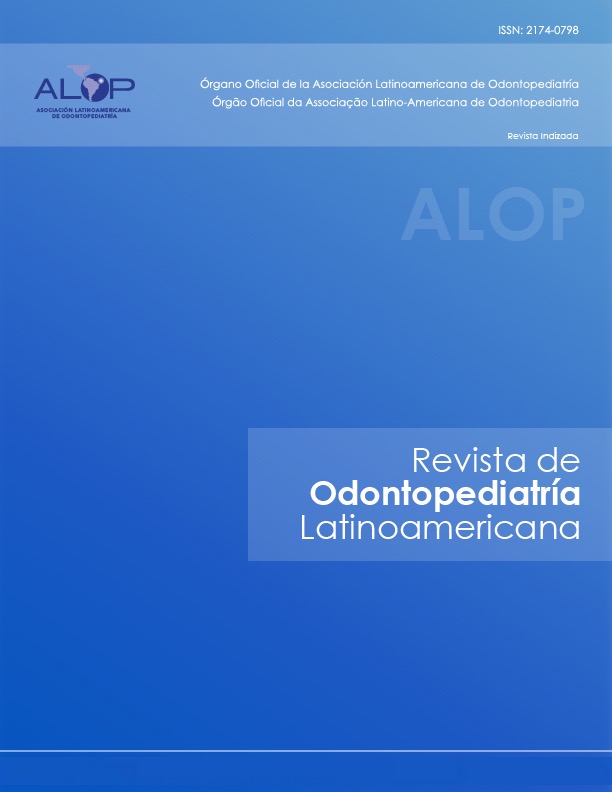Space manteinance after premature loss of primary molars
DOI:
https://doi.org/10.47990/alop.v2i2.64Keywords:
Primary teeth, space maintainersAbstract
Premature loss of primary molars occurs when they are extracted before their physiologic exfoliation timing. Aim: The purpose of this study is to determine the association between premature loss of primary molars and the use of space maintainers. Materials and methods: A descriptive, retrospective, correlacional study was performed, analyzing records of 109 patients, ages 3 to 9 years old, who received dental treatment at the Pediatric Dentistry Postgraduate program UCV. Children with systemic diseases or syndromes were excluded. Socioeconomic status, extracted primary teeth and use of space maintainers were studied. Pearson´s X2 and Student´s T tests (p=0,05) were performed. Results: Mean age was 4,93 ± 1,5 years-old. Prevalence of premature loss of primary teeth was 70,90%, with an average of3,75 ± 2,56 extracted teeth per child. Dental caries was the most frequent cause for extraction (76,5%), and the most affected tooth was the maxillary left primary firs molar (64). 72,12% of patients used space maintainers, with fixed appliances accounting for 52,27%. No statistical significance was found between socioeconomic status, number of extracted teeth or use of space maintainer. Conclusion: High prevalence of premature loss of primary teeth was observed in this sample, belonging to a highly specialized clinic where patients with complex treatment needs are admitted. For most cases satisfactory use of space maintainers was achieved as a preventive measure to avoid oclusal disturbances.
References
Pedersen J, Stensgaard K, Melsen B. Prevalence of malocclusion in relation to premature loss of primary teeth. Community Dent Oral Epidemiol 1978, 6: 204-209.
Medrano J, Celdillo L, Murrieta J. Prevalencia de factores de riesgo para el desarrollo de la oclusión. Rev. ADM, 2002;
LIX (4) 128-133.
Karaiskos N, Wiltshire W, Odlum O, Brothwell D, Hassrd T. Prevenive and Interceptive Orthodontic Treatment Needs o
fan Inner-City Group of 6 -and 9 year Old Canadian Children. JCDA, 2005; 71, (9): 649-649e.
Medina A, Crespo O, Da Silva L. Factores de riesgo asociados a maloclusión en pacientes pediátricos. Acta Odont. Venez. 2010; 48.(2) 1-13
García Y, Da Silva L, Medina A, Crespo O. Efecto de la pérdida prematura de molares primarios sobre la relación horizontal incisiva. Rev. Odontopediatr Latinoam. 2011; 1(1): 49-57.
Brothwell, D. Guidelines on the use of space maintainers following premature loss of primary teeth. J Res Dent 1997;
, (10): 753-766.
Terlaje R, Donly K. Treatment planning for space maintenance in the primary and mixed dentition. J Dent Child 2001;
(2) :109-114.
Bijoor R, Kohli K. Comtemporary Space Maintenance. J Paediatr Dent. 2005; 32-35.
Laing E, Ashley P, Naini F, Gill D. Space maintenance. Int J Paediatr Dent. 2009;19:155-162.
Ram D, Ben M, Efrat J, Moskovitz M. Mantenedores de espacio mandibulares para la prevención de pérdida de espacio,
posterior a la pérdida prematura de molares primarios. Odontol Pediatr. 2010; 9(2):127-140.
Ngan P, Alkire R, Fields H. Management of space problems in the primary and mixed dentitions. J Am Dent Assoc,
; 130, 1330-1339.
FUNDACREDESA. La Caries en la Dentición Primaria. En Estudio Nacional de Crecimiento y Desarrollo Humano de
la República de Venezuela. “Proyecto Venezuela”. Caracas 1986.
Ortiz M, Godoy S, Farias M, Mata M. Pérdida prematura de dientes temporales en pacientes de 5 a 8 años de edad asistidos en la Clínica de Odontopediatria de la Universidad Gran Mariscal de Ayacucho, 2004-2005 2009. Acta Odont Venez
[serie en internet] [citado el 17/06/11]. Disponible en: http://www.ortodoncia.ws/publicaciones/2009/art17.asp.
Cardozo L, Zembrusqui C, Sartori D, Boff I, Pessin V. Avalicäo da prevalëncia de perdas precoces de molares decíduos.
, Pesq Bras em Odontoped Clín Integr.Joao Pessoa. 2005 ;5: (1): 17-22.
Lin YT, Lin WH, Tzer Y, Lin YT. Immediate and six month space changes after premature loss of primary maxillary first
molar. J Am Dent Assoc. 2007;138: 362-368.
Van Der Linden, Frank P.G.M. Transition of the Human Dentition. Michigan : s.n., 1982. Vol. 13.
Fanning E. Effect of Extraction of deciduous molars on the formation and eruption of their successors. Angle Orthod.1962; 32(1): 44-53.
Brin L, y Koyoumdijsky K. The Influence of premature extractions of primary molars on the ultimate root length of their
permanent successors. J Dent Res. 1981; 60, 962-5.
Rood H, Atkin J. Denture satisfaccion and clinical performance in a paediatric population. J Int Paeditric Dent. 2000;
-37.
Downloads
Published
Issue
Section
License
Copyright (c) 2012 Latin American Pediatric Dentistry Journal

This work is licensed under a Creative Commons Attribution-NonCommercial-ShareAlike 4.0 International License.























